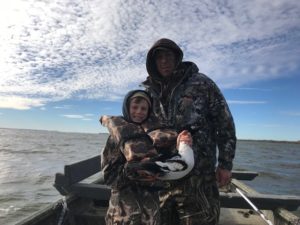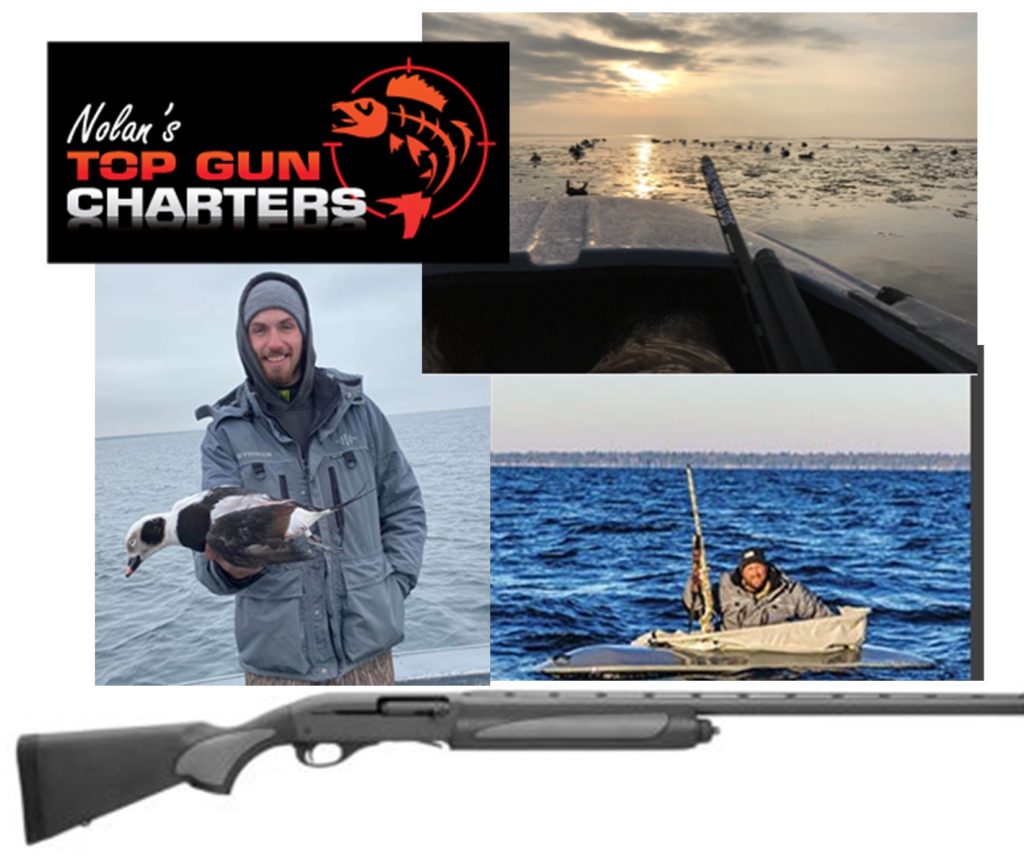By Bruce Urben, President
This article originally appeared in Wisconsin Waterfowl Association’s June 2020 Open Water Newsletter edition. All photos courtesy Bruce Urben, taken while layout hunting on the bay of Green Bay.
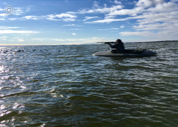 Waterfowl Hunting has changed over the last fifteen years on the bay of Green Bay. The bay was historically known as a waterfowl hotbed, and indeed is still a stopover for northern migration flights each fall. Hunters dotted the shoreline landscape for years with their primitive or elaborate blinds to try and fool the wary and tired migrants. Some shore hunters have been using the same blinds for years. Don’t get me wrong, shore hunters still dot the landscape and harvest their share of ducks on the bay, even though shore cattails and high water has caused erosion and removal of cover, but layout boat hunting has been popularized in the last fifteen years. Maybe because of the shore pressure pushing birds to open water, maybe for hunters to get away from shoreline conflicts with other concentrated hunter populations, or maybe for the shear joy of having ducks land on top of you when the migration is on. I know it is not unusual to encounter waterfowl guides from Sheboygan, Milwaukee and Chicago at the boat landings now with their layout rigs and tender boats fully equipped for open water hunting.
Waterfowl Hunting has changed over the last fifteen years on the bay of Green Bay. The bay was historically known as a waterfowl hotbed, and indeed is still a stopover for northern migration flights each fall. Hunters dotted the shoreline landscape for years with their primitive or elaborate blinds to try and fool the wary and tired migrants. Some shore hunters have been using the same blinds for years. Don’t get me wrong, shore hunters still dot the landscape and harvest their share of ducks on the bay, even though shore cattails and high water has caused erosion and removal of cover, but layout boat hunting has been popularized in the last fifteen years. Maybe because of the shore pressure pushing birds to open water, maybe for hunters to get away from shoreline conflicts with other concentrated hunter populations, or maybe for the shear joy of having ducks land on top of you when the migration is on. I know it is not unusual to encounter waterfowl guides from Sheboygan, Milwaukee and Chicago at the boat landings now with their layout rigs and tender boats fully equipped for open water hunting.
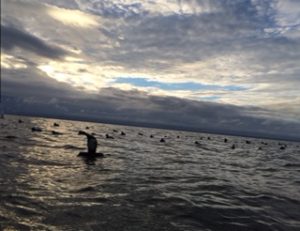 The upper and lower bays of Green Bay provide refuge to tens of thousands of ducks each fall on their migration south from their northern nesting areas in Canada and the prairie pothole regions of the Dakotas and Minnesota. Hunters can set their watch to flights, as various species of diver ducks show up for their stopover rest and feeding frenzy in the bay. Early waterfowl arrivals include teal and wood ducks, then mallards, and in early October come the redheads, followed by scaup, canvasbacks, buffleheads, scoters, long tails, and then the golden eyes round out the traveling diver migrants later in the season. Each year it seems that the bay’s nesting ducks are increasing in number, but several species of diver ducks seem to be staying longer, and some choose to call the bay home and nest right here.
The upper and lower bays of Green Bay provide refuge to tens of thousands of ducks each fall on their migration south from their northern nesting areas in Canada and the prairie pothole regions of the Dakotas and Minnesota. Hunters can set their watch to flights, as various species of diver ducks show up for their stopover rest and feeding frenzy in the bay. Early waterfowl arrivals include teal and wood ducks, then mallards, and in early October come the redheads, followed by scaup, canvasbacks, buffleheads, scoters, long tails, and then the golden eyes round out the traveling diver migrants later in the season. Each year it seems that the bay’s nesting ducks are increasing in number, but several species of diver ducks seem to be staying longer, and some choose to call the bay home and nest right here.
Most layout boat hunters started open water hunting in a blind boat camouflaged to confuse wary waterfowl. This is still an effective method, however ducks become quickly educated to these tall floating behemoths and become blind shy quickly as the season goes on.
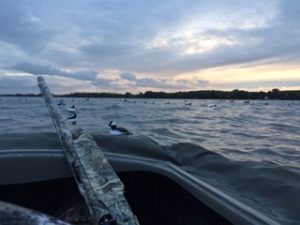 A layout boat is a low profile, non motorized oval-like boat used by diver duck hunters to hide in open water. Layout boats come in one and two person models. The main focus of the layout boat is to put the hunter very close to the decoys, if not in them for additional concealment. Diver ducks (bluebills, canvasbacks, golden eyes, redheads, buffleheads, long tailed ducks and sea ducks like scoters and eiders) are targeted because divers often fly low on the water and will not notice the sides of the boat. Layout boats are often placed within the decoy spread, so the decoys help to conceal the sides of the boat.
A layout boat is a low profile, non motorized oval-like boat used by diver duck hunters to hide in open water. Layout boats come in one and two person models. The main focus of the layout boat is to put the hunter very close to the decoys, if not in them for additional concealment. Diver ducks (bluebills, canvasbacks, golden eyes, redheads, buffleheads, long tailed ducks and sea ducks like scoters and eiders) are targeted because divers often fly low on the water and will not notice the sides of the boat. Layout boats are often placed within the decoy spread, so the decoys help to conceal the sides of the boat.
Open water hunting in Wisconsin is defined as being greater than 500 feet from shore.
So, what kind of equipment is needed for layout boat hunting?
- Layout boat or boats: Coast Guard approved boats are a necessity with flotation built into them. Boats are usually painted to resemble the water color they are hunting in (gray or bay green).
- Tender boat: Usually a 17-24 foot boat capable of transporting hunters, decoys and layout boat(s). Tender boats must be capable of deploying and retrieving the layouts, decoys and other equipment safely.
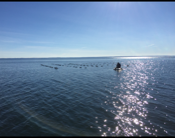 Decoys: Open water hunting requires substantially larger decoy spreads to attract divers. Safety for divers seems to be in numbers, and they tend to migrate to large spreads. Decoys are deployed on long lines (100-140 feet long) with crab clips to space them. The long lines are anchored on each end. Deploying long lines from a boat in windy conditions is an art in and of itself. Decoy species will vary depending on migrating species present. For example, redheads usually come through early, while golden eyes come through later, so decoy species will need to be changed to accommodate.
Decoys: Open water hunting requires substantially larger decoy spreads to attract divers. Safety for divers seems to be in numbers, and they tend to migrate to large spreads. Decoys are deployed on long lines (100-140 feet long) with crab clips to space them. The long lines are anchored on each end. Deploying long lines from a boat in windy conditions is an art in and of itself. Decoy species will vary depending on migrating species present. For example, redheads usually come through early, while golden eyes come through later, so decoy species will need to be changed to accommodate.- Movement decoys: Divers are attracted to movement within the decoy spread from wave movement, or by the use of motorized flapping decoys on floats or wind powered rotating decoys. Some experienced layout hunters will even use a flagging technique to put more motion in their setup to gain divers’ attention.
- Communication with tender boat: Some sort of communication is necessary between the layout boat(s) and the tender boat. That can be hand signals or two-way communication radios. Communication is necessary to call in the tender to retrieve downed ducks or to react to changing wind or wave conditions.
- Location of Tender Boat: The tender boat is usually anchored 1/4 to 1/2 mile upwind of the setup. The tender monitors the layout boat hunters routinely. Common sense must be used in anchoring the tender so as not to interfere with other open water or shore hunters. Usually, two people man the tender boat to net downed birds, but some experienced tenders can operate with one person.
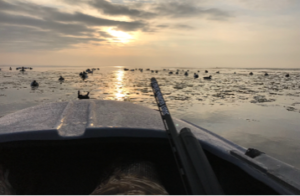 Setup of the rig is unique to each open water hunter, but the following are some general rules: Deploy five to eight long lines of decoys with 18-24 decoys on each line, oriented with the wind. Movement decoys are spaced in intervals between the long lines. Layout boats should be placed upwind of the end of the long line setup as divers generally land into the wind. Position of layout boats can be placed near or in the decoy spread. Divers tend to follow the long lines into the spread and usually fly right on the deck one to two feet above the water.
Setup of the rig is unique to each open water hunter, but the following are some general rules: Deploy five to eight long lines of decoys with 18-24 decoys on each line, oriented with the wind. Movement decoys are spaced in intervals between the long lines. Layout boats should be placed upwind of the end of the long line setup as divers generally land into the wind. Position of layout boats can be placed near or in the decoy spread. Divers tend to follow the long lines into the spread and usually fly right on the deck one to two feet above the water.
Shooting from the layout boat is an acquired expertise. Novice open water hunters we take out tend to either sit up too early or too late when they first start. Estimation of distance and speed within the spread will be acquired after the first few volleys on incoming ducks. Some species decoy to edges of the spread and others tend to decoy directly with setting wings. Take choppy water, wind and varying direction of decoying birds, and layout boat hunting can be an exhilarating experience, up close and personal with the ducks.
Many open water hunters have different techniques and methods based on their observations, past experience and tendencies of the birds on a particular day. One thing is for sure, scouting is still required to locate the divers. They tend to be located in large rafts and in areas where food is available. Scouting improves your chances of being in the divers’ flight patterns. Once you try open water layout boat hunting, you will be hooked.
One caution, however: bay weather can change in an instant! Consult forecasts and constantly and continually monitor weather changes, because conditions can deteriorate in minutes and boat, hunter and decoy retrieval can be dangerous in heavy seas.
I hope you all have the opportunity to experience open water layout boat hunting; but another caution, it is addicting!
Want to try your hand? Enter for your chance to win a 4-person Guided Open Water Hunt on Lake Michigan or Green Bay with Nolan’s Top Gun Charters for the 2020 or 2021 Season PLUS a Remington Versamax 12ga 3 1/2″ Mag. Semi-Auto Shotgun to get the lucky winner started on their own exploration of these waters.

